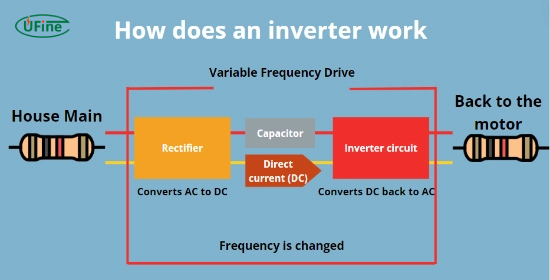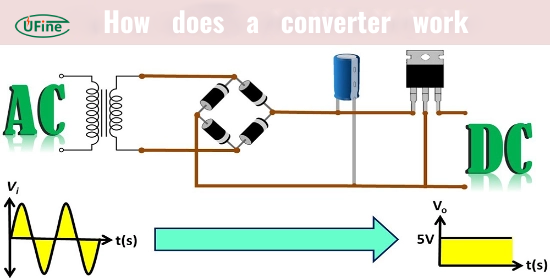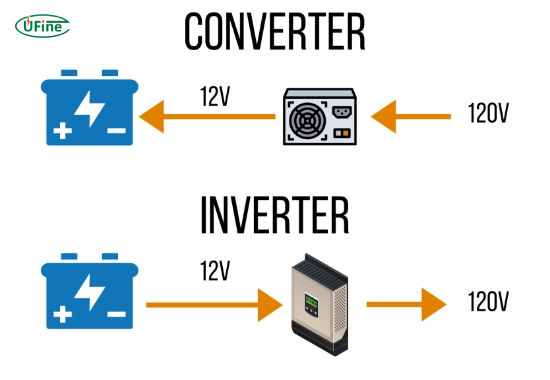You might have encountered the terms inverter and converter when dealing with electrical and electronic devices. While both are essential components in power management systems, they serve different purposes. But what exactly sets them apart? In this article, we’ll break down the key differences between inverters and converters, their functions, and their applications in an easy-to-understand way.
Part 1. What is an inverter?
An inverter is an electrical device that converts direct current (DC) into alternating current (AC). Many household appliances, electronic devices, and industrial machines rely on AC power. Renewable energy systems like solar panels generate DC electricity, and inverters convert it into AC for everyday use.
How does an inverter work?
An inverter works through a combination of circuits that transform the steady flow of DC electricity into alternating waves of AC electricity. The process typically involves:
- Input DC power: This could be from a battery, solar panel, or another DC source.
- Oscillation: The DC signal is passed through oscillation circuits or transistors to create waves.
- Transformation into AC: The system then shapes the oscillating current into a sinusoidal AC waveform compatible with most appliances.
Types of Inverters
Inverters come in various types based on their output waveform and application:
- Square Wave Inverters: These produce a fundamental square wave output suitable for simple devices but not ideal for sensitive electronics.
- Modified Sine Wave Inverters: These provide a stepped approximation of a sine wave, making them compatible with a broader range of devices than square wave inverters.
Pure sine wave inverters generate a smooth sine wave output, making them ideal for all appliances, especially sensitive electronics like computers and medical devices.
Applications of Inverters
Various applications widely use inverters, including:
- Solar energy systems: Converting solar-generated DC power into AC for household use.
- Uninterrupted Power Supply (UPS): Providing backup AC electricity during power outages.
- Portable power stations: Enabling the use of AC appliances in off-grid situations.
All You Need To Know About Battery InverterInverter vs Generator: What’s the Difference and Which Should You Choose?
Part 2. What is a converter?
Conversely, a converter is a device that changes electrical power from one form to another. Unlike an inverter, which changes DC to AC explicitly, a converter can perform various transformations:
- AC to DC: Known as a rectifier.
- DC to DC: Systems often use a DC-DC converter to increase or decrease voltage.
- AC to AC: Known as a cycloconverter.
How does a converter work?
Converters use various electrical components, such as diodes, transistors, and transformers, to adjust electricity’s form, voltage, or frequency. The type of conversion determines the specific configuration.
Applications of Converters
Converters are integral in many industries and consumer applications, such as:
- Charging electronics: Transforming AC wall power into DC for laptops and smartphones.
- Electric vehicles: Managing power between the battery and motor systems.
- Industrial machines: Adjusting voltage or frequency to match equipment requirements.
Part 3. What are the key differences between an inverter and a converter?
Understanding the differences between an inverter and a converter is essential for anyone working with electrical systems. Here’s a concise description of their key distinctions:
- Functionality: An inverter converts direct current (DC) into alternating current (AC), while a converter changes AC to DC or adjusts DC voltage levels.
- Input Type: Inverters only accept DC input, whereas converters can accept AC and DC inputs.
- Output Type: Inverters produce AC output, while converters, depending on their design, can produce either AC or DC output.
- Common Uses: Inverters are used in renewable energy systems and electric vehicles, while converters are typically used in power supplies and battery chargers.
- Waveform Quality: Inverters can produce different waveforms (square, modified sine, or pure sine), while converters focus on voltage adjustment without changing the waveform type.
Here’s a comparison table summarizing these differences:
| Feature | Inverter | Converter |
|---|---|---|
| Primary Function | Converts DC to AC | Converts AC to DC or changes DC voltage |
| Input Type | Only accepts DC input | Accepts both AC and DC input |
| Output Type | Produces AC output | Produces either AC or DC output |
| Common Applications | Solar energy systems, UPS, electric vehicles | Power supplies, battery chargers |
| Waveform Quality | Can produce square, modified sine, or pure sine waves | Focuses on voltage adjustment without changing waveform type |
This table provides a clear overview of the primary differences between inverters and converters, making understanding their roles in electrical systems easier.
Part 4. Why are inverters essential in renewable energy systems?
Inverters are critical in modern renewable energy systems like solar panels and wind turbines. These systems typically generate DC power that is incompatible with the AC-based electrical grid and household appliances. By converting DC to AC, inverters ensure the energy produced is usable.
Additionally, inverters often include features like MPPT (Maximum Power Point Tracking), which optimizes the efficiency of solar panels.
Part 5. Why are converters essential in electronics?
Converters are invaluable in electronics because most devices require a specific voltage and current type to function correctly. For example:
- Smartphones: Plugging your phone into an AC outlet requires a converter inside the charger to provide the correct DC voltage.
- LED lighting: AC power is converted to DC to operate these lights efficiently.
- Electric vehicles: Converters regulate power between the battery, motor, and auxiliary systems.
With converters, it is possible to adapt electricity to meet the needs of different devices.
Part 6. Can an inverter be a converter?
Yes, an inverter can technically be a converter because it transforms electricity from one form to another. However, not all converters are inverters. An inverter’s specific task—DC to AC conversion—distinguishes it within the broader converter category.
Part 7. Which one is better: inverter or converter?
When deciding whether you need an inverter or a converter, consider the following factors:
- Power Source: If your primary source is DC (like batteries), you will need an inverter to convert it to AC for your appliances.
- Device Requirements: A converter must adjust voltage levels for specific devices or convert AC from the main supply into usable DC.
- Application Context: Renewable energy systems or backup power solutions typically require an inverter, while battery charging or powering low-voltage electronics calls for a converter.
Part 8. Real-world examples of inverters and converters
Examples of inverters:
- Home solar systems: Solar inverters convert DC power from panels into AC for home use.
- Power backup systems: Inverters supply AC power during outages.
- Car inverters: Allow you to use AC devices in vehicles with DC batteries.
Examples of converters:
- Phone chargers: Convert AC from the wall to DC for your phone.
- Laptop adapters: Step down from high to lower voltage, as laptops require.
- Voltage stabilizers: Adjust voltage levels for sensitive electronics.
Part 9. What are the technical limitations of inverters and converters?
Although inverters and converters are incredibly useful, they come with limitations:
Inverters:
- Efficiency losses during conversion.
- Limited to DC-to-AC conversion.
- It can be costly for high-power applications.
Converters:
- It may produce heat during operation, requiring cooling systems.
- Complex configurations for specific tasks (like AC-to-AC conversion).
- Potential for power quality issues if not appropriately designed.
Part 10. FAQs
-
What is the difference between AC and DC power?
AC (Alternating Current) periodically reverses direction, making it suitable for long-distance transmission. DC (Direct Current) flows in one direction and is more common in batteries and electronics. -
Can I use an inverter in place of a converter?
No, inverters are designed explicitly for DC-to-AC conversion, while converters handle a broader range of tasks, including AC-to-DC and DC-to-DC conversions. -
Why do solar panels need an inverter?
Solar panels generate DC power that is incompatible with the AC-based electrical grid and most home appliances. An inverter converts this DC power into AC for household use. -
Are converters energy-efficient?
Modern converters achieve high efficiency, often exceeding 90%. However, the conversion process loses some energy, such as heat. -
Can one device act as both an inverter and a converter?
Yes, some hybrid devices can perform both functions, such as inverters with integrated DC chargers that can convert AC to DC for battery storage.
Related Tags:
More Articles

How to Choose the Best Jigsaw Tool Battery for Long-Lasting Power
Discover the top jigsaw tool batteries for power & runtime. Compare Li-ion vs. NiCd, top brands, and tips to extend battery life. Read now
The Logistics of Bulk Battery Orders: Shipping, Storage, and Hazmat Compliance
Learn how to safely manage bulk battery orders with tips on shipping, storage, and hazmat compliance for smarter, safer logistics.
Microcurrent Facial Device Battery Guide & Tips
Learn all about microcurrent facial device batteries, from types to lifespan, and how to choose a reliable supplier for long-lasting, safe skincare performance.
Power Pack Battery vs. Power Bank: What’s the Difference?
Power pack vs power bank: Learn the key differences, pros, and best uses to choose the right portable power source for your lifestyle.
What Is a Power Pack Battery and How Does It Work?
A power pack battery stores energy for off-grid use, emergencies, or travel. Learn how it works and how to choose the right one for your needs.






